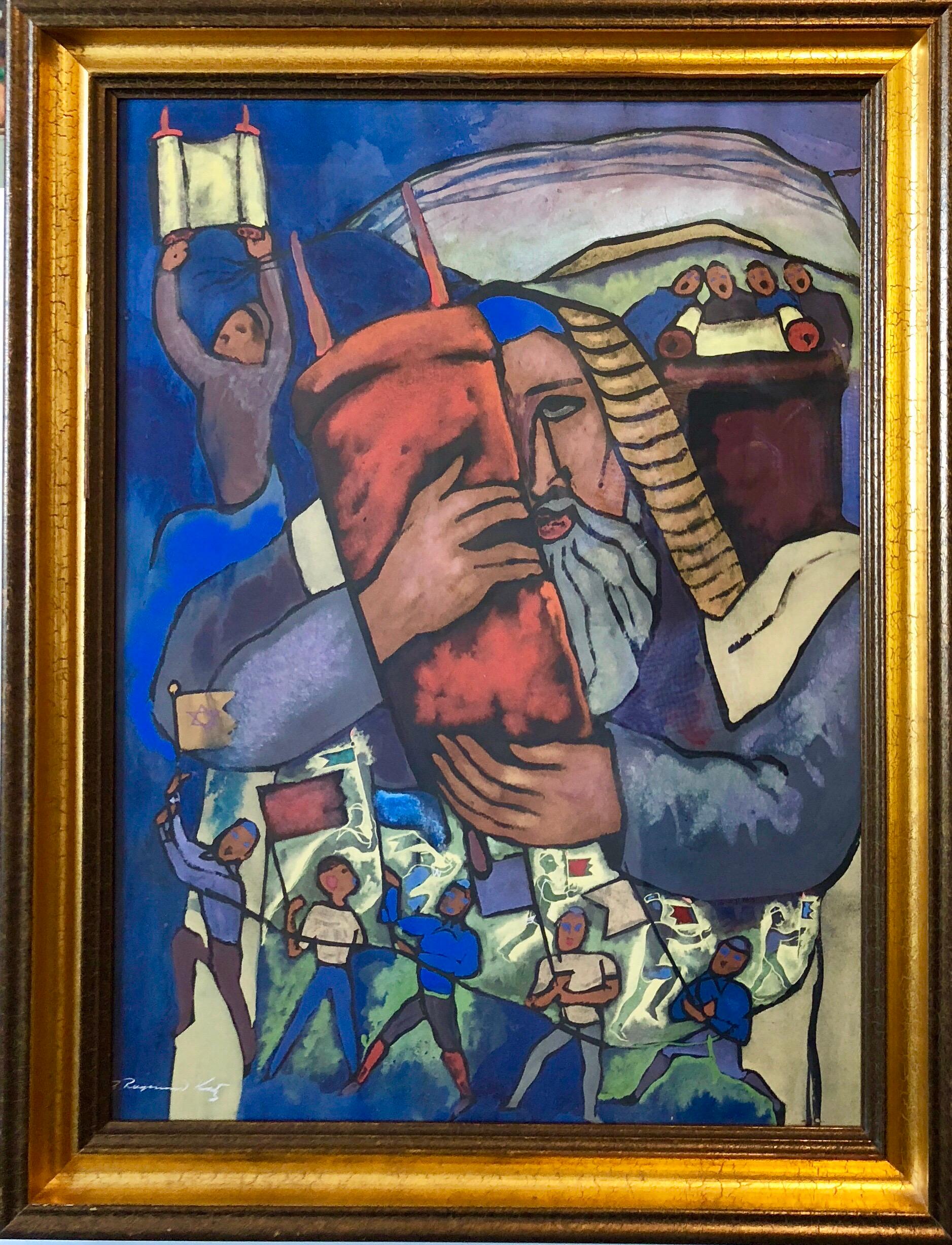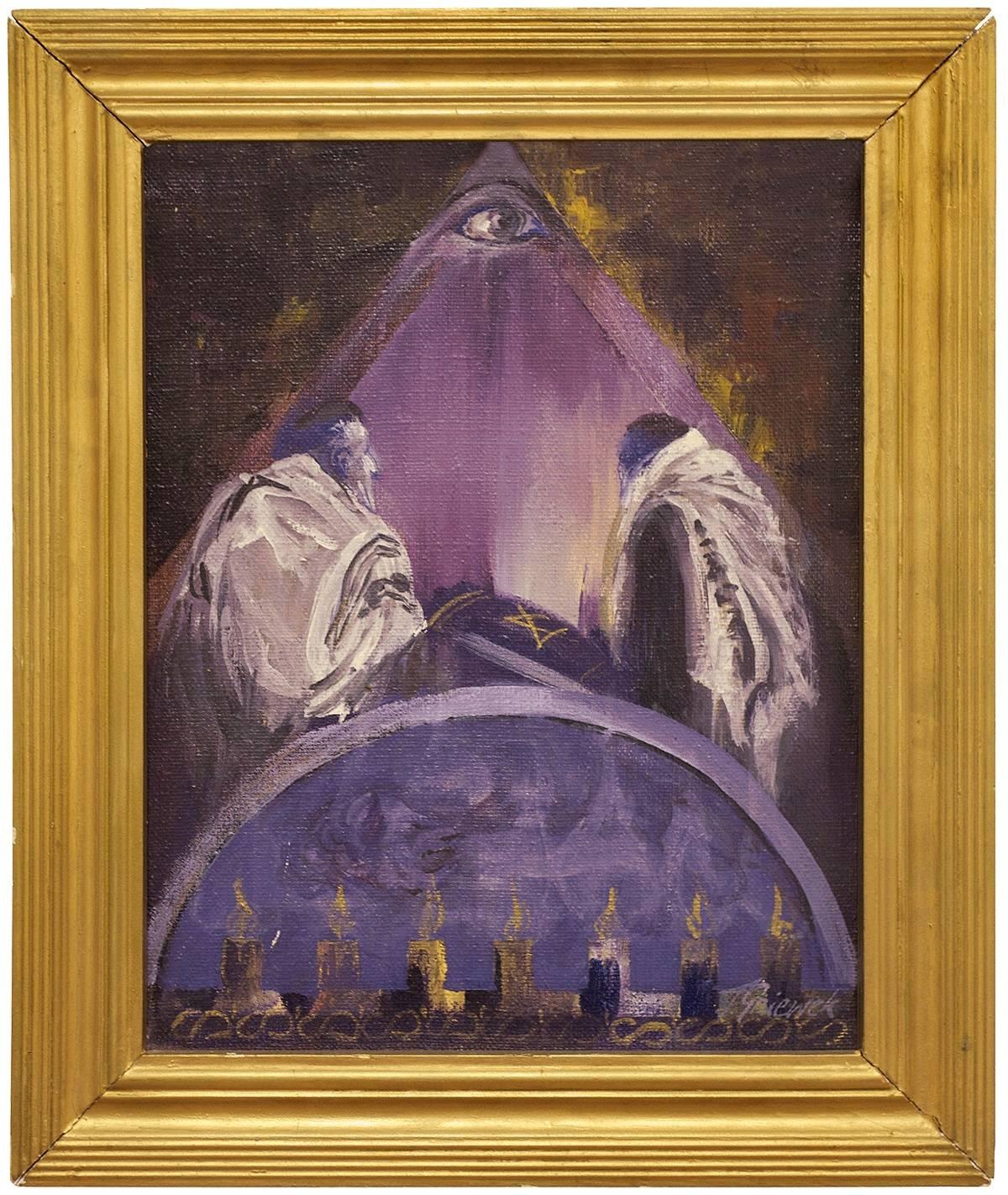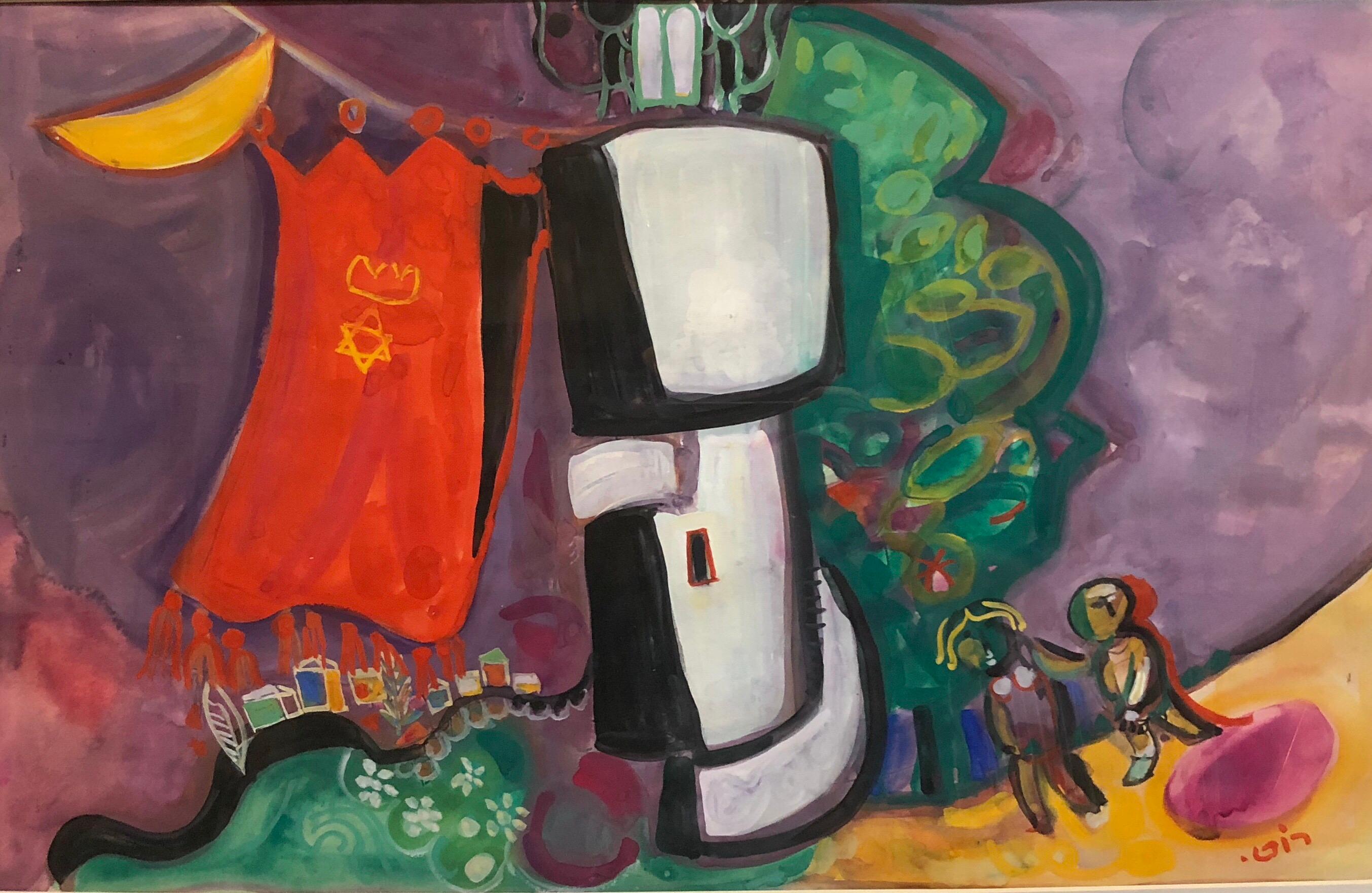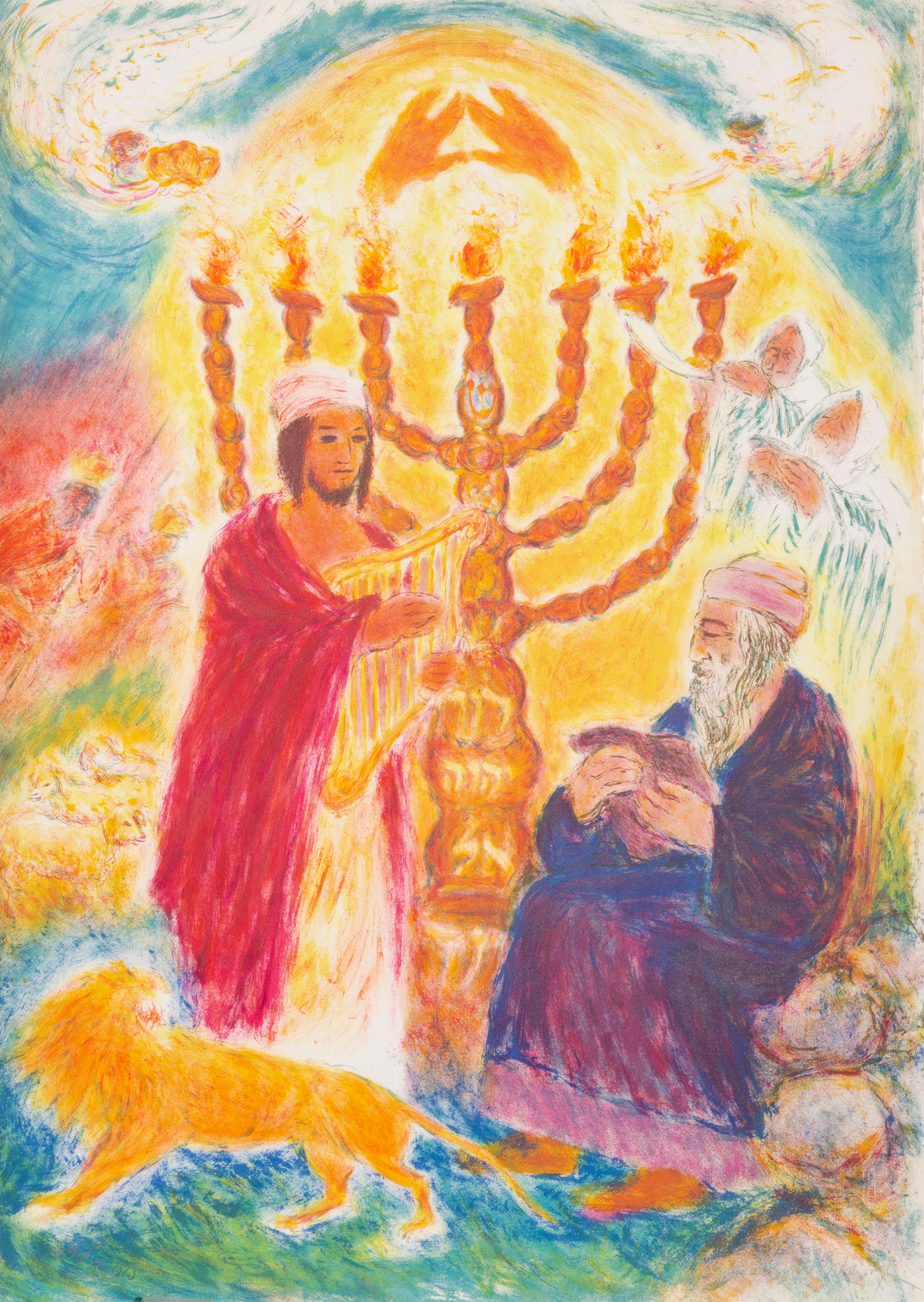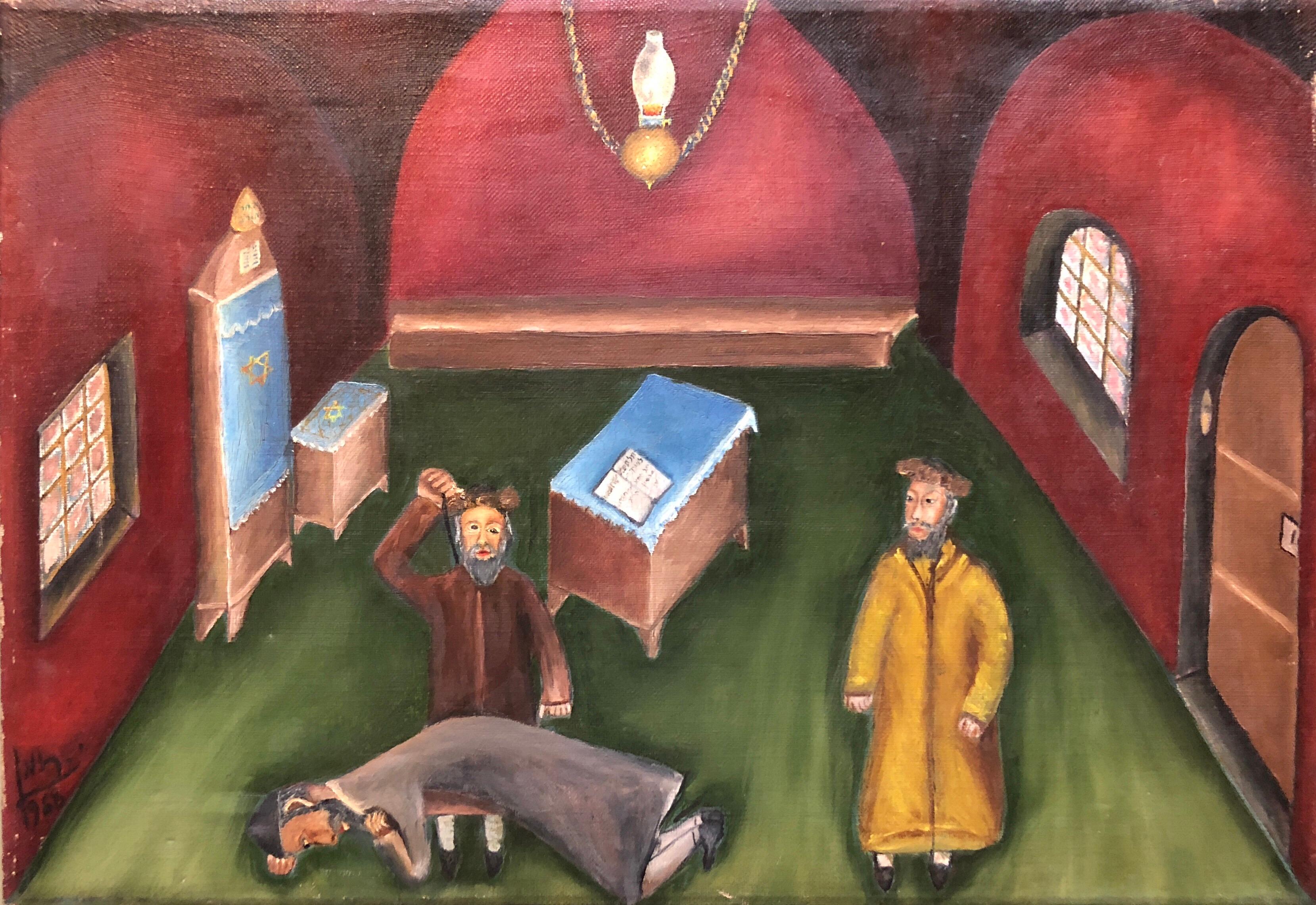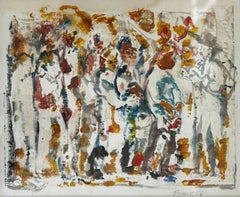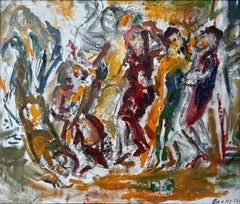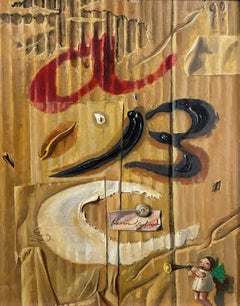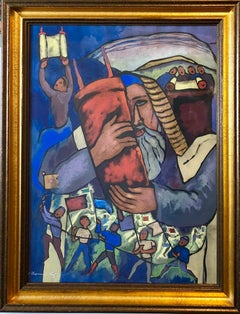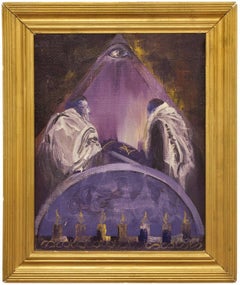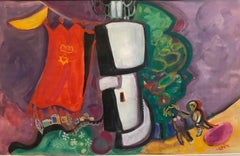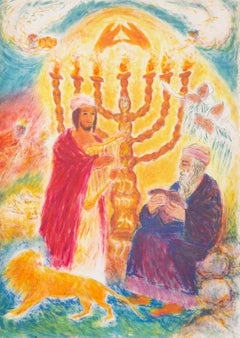Items Similar to "Simchat Torah in the Synagogue, " Leo Schutzman, Jewish Folk Art
Want more images or videos?
Request additional images or videos from the seller
1 of 9
Leo Schutzman"Simchat Torah in the Synagogue, " Leo Schutzman, Jewish Folk Artcirca 1958
circa 1958
$10,000
£7,567.84
€8,692.06
CA$14,220.48
A$15,417.93
CHF 8,125.22
MX$187,497.10
NOK 101,090.62
SEK 95,597.83
DKK 64,891.13
About the Item
Leo Schutzman (1878 - 1962)
Simchat Torah in the Synagogue, circa 1958
Oil on canvas
40 x 36 inches
Signed lower left
Provenance:
The Contemporaries Gallery, New York, circa 1958
Leo (Kyle) Schutzman (1878-1962) developed a reputation in New York in the 1950s as the ‘Jewish Grandma Moses.’ The characterization was particularly appropriate. Both artists only took up painting in a serious way in their old age after retiring from work. They also shared a popular aesthetic style then known as ‘primitivism’ or ‘naive art,’ far from the abstract expressionism that was the art critic’s darling at the time.
Schutzman was born Leo Kyle in Russia around 1878. His father died when he was 3 years old and he immigrated to England in his teens, where he remained for 9 years. When he moved to the United States in 1905, he took the name Schutzman after a German family who was renting to his nephew, Louis Kyle.
In New York City, Schutzman worked in the Jewish-dominated clothing industry, producing underwear as well as lace and embroidery. He founded the Victory Undergarment Company and the business was successful enough to provide for his family until he retired at about age 74.
After retirement, Schutzman took art courses at the Brooklyn Museum and began painting. He often depicted scenes of Jewish religious life that he remembered from childhood in Russia. His work seemed the very definition of ‘naive art’ as it was personified by Grandma Moses in the 1950s. His clumsy human figures sometimes had no features at all, or were portrayed with just a slash for the mouth and two dots for the eyes. He had only the vaguest sense of perspective and often used dissonant colors in unusual places.
Schutzman had his first one-man show in 1958, when he was 80 years old, at The Contemporaries gallery (992 Madison Ave.). His optimistic primitivism was popular in the United States in the 1950s as was his backstory; an immigrant who had succeeded as an entrepreneur in the capitalist system before affirming the democratic individualist creed that everyone had talents and could accomplish something at any age. He was soon socializing at parties with people like heiress/artist Gloria Vanderbilt. One of his ‘non-Jewish’ works depicting a winter carnival was chosen in 1962 for the United Nations Children’s Fund Christmas Card Collection.
When Grandma Moses died in 1961, naive art began to lose popularity Schutzman was living in Glendale Queens when he died at age 83 in 1962 and his reputation soon disappeared. In 1986, two of his paintings were acquired by the Jewish Museum in New York City. One of them, “The Wedding,” (c. 1960) was an iconic portrait of an Ashkenazic wedding. It has been reproduced by the Jewish Museum on popular stationery, and has appeared in popular books such as The Complete Idiot's Guide to Understanding Judaism.
Schutzman had three children, one of whom, Steven Kyle (1913-1979; nee Siegfried Schutzman)), married Betty Comden (1917-2006) in 1942. Comden, along with her writing partner Adolph Green, was the award-winning lyricist of many memorable Broadway and film musicals of the mid-1900s including “Singin’ in the Rain,” “On the Town,” “Peter Pan,” and “The Bandwagon.”
Leo Schutzman never minded the comparisons to Grandma Moses. He actually visited her in 1953 to show her some of his works and receive some advice from the 93-year-old painter. Both artists were noted for expunging the grim realities of life, choosing instead to focus on simple and generally joyful scenes. Schutzman once summed up his philosophy: “It doesn’t make any difference to me what they call my style as long as people enjoy the paintings.”
- Creator:Leo Schutzman (1878 - 1962, American, Russian)
- Creation Year:circa 1958
- Dimensions:Height: 46 in (116.84 cm)Width: 42 in (106.68 cm)
- Medium:
- Movement & Style:
- Period:
- Condition:Some craquelure and stretcher marks. Recently cleaned and restored.
- Gallery Location:New York, NY
- Reference Number:1stDibs: LU184129905302
Leo Schutzman
Leo (Kyle) Schutzman (1878?-1962) developed a reputation in New York in
the 1950s as the ‘Jewish Grandma Moses.’ The characterization was particularly
appropriate. Both artists only took up painting in a serious way in their old age
after retiring from work. They also shared a popular aesthetic style then known as
‘primitivism’ or ‘naive art,’ far from the abstract expressionism that was the art
critic’s darling at the time. Schutzman was born Leo Kyle in Russia around 1878. His father died when
he was 3 years old and he immigrated to England in his teens, where he remained
for 9 years. When he moved to the United States in 1905, he took the name
Schutzman after a German family who was renting to his nephew, Louis Kyle.
In New York City, Schutzman worked in the Jewish-dominated clothing
industry, producing underwear as well as lace and embroidery. He founded the
Victory Undergarment Company and the business was successful enough to
provide for his family until he retired at about age 74. After retirement, Schutzman took art courses at the Brooklyn Museum and
began painting. He often depicted scenes of Jewish religious life that he
remembered from childhood in Russia. His work seemed the very definition of
‘naive art’ as it was personified by Grandma Moses in the 1950s. His clumsy
human figures sometimes had no features at all, or were portrayed with just a slash
for the mouth and two dots for the eyes. He had only the vaguest sense of
perspective and often used dissonant colors in unusual places. Schutzman had his first one-man show in 1958, when he was 80 years old, at
The Contemporaries gallery (992 Madison Ave.). His optimistic primitivism was
popular in the United States in the 1950s as was his backstory; an immigrant who
had succeeded as an entrepreneur in the capitalist system before affirming the
democratic individualist creed that everyone had talents and could accomplish
something at any age. He was soon socializing at parties with people like
heiress/artist Gloria Vanderbilt. One of his ‘non-Jewish’ works depicting a winter
carnival was chosen in 1962 for the United Nations Children’s Fund Christmas
Card Collection. When Grandma Moses died in 1961, naive art began to lose popularity
Schutzman was living in Glendale Queens when he died at age 83 in 1962 and his
reputation soon disappeared. In 1986, two of his paintings were acquired by the
Jewish Museum in New York City. One of them, “The Wedding,” (c. 1960) was an
iconic portrait of an Ashkenazic wedding. It has been reproduced by the Jewish
Museum on popular stationery, and has appeared in popular books such as The
Complete Idiot's Guide to Understanding Judaism.
About the Seller
5.0
Platinum Seller
Premium sellers with a 4.7+ rating and 24-hour response times
Established in 2022
1stDibs seller since 2022
123 sales on 1stDibs
Typical response time: <1 hour
- ShippingRetrieving quote...Shipping from: Saratoga Springs, NY
- Return Policy
Authenticity Guarantee
In the unlikely event there’s an issue with an item’s authenticity, contact us within 1 year for a full refund. DetailsMoney-Back Guarantee
If your item is not as described, is damaged in transit, or does not arrive, contact us within 7 days for a full refund. Details24-Hour Cancellation
You have a 24-hour grace period in which to reconsider your purchase, with no questions asked.Vetted Professional Sellers
Our world-class sellers must adhere to strict standards for service and quality, maintaining the integrity of our listings.Price-Match Guarantee
If you find that a seller listed the same item for a lower price elsewhere, we’ll match it.Trusted Global Delivery
Our best-in-class carrier network provides specialized shipping options worldwide, including custom delivery.More From This Seller
View All"The Marriage Proposal (Family Gathering), " Leo Schutzman, Jewish Folk Art
By Leo Schutzman
Located in New York, NY
Leo Schutzman (1878 - 1962)
The Marriage Proposal, circa 1958
Oil on canvas
24 x 20 inches
Signed lower left
Leo (Kyle) Schutzman (1878-1962) developed ...
Category
1950s Folk Art Figurative Paintings
Materials
Canvas, Oil
"The Gathering" Theresa Bernstein, Abstracted Figures Ashcan School Artist
By Theresa Bernstein
Located in New York, NY
Theresa Bernstein
The Gathering, circa 1990
Signed lower right
Mixed media on paper
9 x 10 3/4 inches
Theresa F. Bernstein was born in Philadelphia in 1895 to cultured, middle-clas...
Category
1990s Abstract Abstract Drawings and Watercolors
Materials
Paper, Mixed Media
"Untitled" Theresa Bernstein, Expressionist Work by American Ashcan Artist
By Theresa Bernstein
Located in New York, NY
Theresa Bernstein
Untitled, circa 1990
Signed lower right
Oil on canvas
16 x 20 inches
Theresa F. Bernstein was born in Philadelphia in 1895 to cultured, middle-class immigrant par...
Category
1990s Abstract Abstract Paintings
Materials
Canvas, Oil
"The Beginning" Aaron Bohrod, Pun Humor, Magic Realism, Alphabet Letters, Text
By Aaron Bohrod
Located in New York, NY
Aaron Bohrod
The Beginning, 1990
Signed center
Oil on gesso board
10 x 8 inches
Aaron Bohrod's work has not been limited to one style or medium. Initially recognized as a regionalis...
Category
1990s Realist Animal Paintings
Materials
Oil, Board
"Twice told tale (23)" David Shapiro, Rare Oil on Canvas Symbolic Composition
By David Shapiro
Located in New York, NY
David Shapiro
Twice told tale (23), 1984
Signed and dated on verso
Oil on canvas
44 x 22 inches
David Shapiro was born in 1944 in Brooklyn, New York. His artwork, as described by a...
Category
1980s Abstract Abstract Paintings
Materials
Canvas, Oil
"Insiders Say Too Much is Enough" Lawrence Philp, Abstracted Surrealist Forms
Located in New York, NY
Lawrence Philp
Insiders Say Too Much is Enough
Signed lower left; titled on overlap
Oil on canvas
70 x 59 1/2 inches
Lawrence Philp, the son of Jamaican immigrants, studied at the ...
Category
1970s Surrealist Abstract Paintings
Materials
Canvas, Oil
You May Also Like
Chicago Jewish Modernist Judaica Painting Simchat Torah WPA Artist Israeli Flags
By Alexander Raymond Katz
Located in Surfside, FL
This has young ISraeli pioneers dancing with the flag as typical of works of the late British mandate Palestine era early state of Israel.
Genre: Modern
Subject: Figurative (stained glass style)
Medium: Mixed media gouache on paper
Hand signed lower left
Alexander Raymond Katz, Hungarian / American (1895 – 1974)
Alexander Raymond Katz was born in Kassa, Hungary, and came to the United States in 1909. He studied at the Art Institute of Chicago and the Chicago Academy of Fine Arts. In the late 1920s, he worked as a director of the Poster Department at Paramount Studios. He was appointed the Director of Posters for the Chicago Civic Opera in 1930.
During the Great Depression, notable architect Frank Lloyd Wright urged Katz to become a muralist. In 1933, he was commissioned to paint a mural for the Century of Progress exposition in Chicago. In 1936, he painted the mural History of the Immigrant for the Madison, Ill., post office. Katz’s works were included in various exhibitions and now are part of several museum collections, including those of the Art Institute of Chicago; Corcoran Gallery of Art, Washington, D.C.; and the Jewish Museum, New York. His murals, bas-reliefs and stained glass designs adorn more than 200 Jewish synagogues in the United States.
Katz and other Jewish artists in Chicago who expressed Jewish and Biblical themes were inspired by the artist Abel Pann (1883-1963). Pann, who is regarded as the leading painter of the Land of Israel, exhibited in the Art Institute of Chicago in 1920.
Early in his career, Katz began to explore the artistic possibilities inherent in the characters of the Hebrew alphabet. He developed aesthetic and philosophical interpretations of each letter and became the leading innovator and pioneer in the field of Hebraic art.
Katz applies this concept in the woodcut Moses and the Burning Bush. Hebrew letters appears in Moses’ head, his cane and inside the flame. The initial of Moses’ name crowns his head. The letter in the flame is the first letter of the name of God. A combination of images and Hebrew letters appeared commonly in illustrations of the scene Moses and the Burning Bush in the Haggadah, the book of Passover.
The symbolism of the burning bush corresponds to the motifs of A Gift to Biro-Bidjan. Among the fourteen participating artists were notable Chicago modernists Todros Geller, Mitchell Siporin...
Category
Mid-20th Century Modern Figurative Paintings
Materials
Paper, Gouache
Kabbalah Judaica Torah Painting "SWIATTO TORY I" Synagogue interior
By Teresa Gniewek
Located in Surfside, FL
Genre: Surrealism
Subject: Religious
Medium: Acrylic
Surface: Linen
Country: Poland
Dimensions: 11 3/4" x 9 1/4"
Dimensions w/Frame: 14 1/2" x 12" x 1 1/4"
SWIATTO TORY I (World of Torah) Polish Jewish artwork
A moody atmospheric synagogue interior with all seeing eye
Category
20th Century Contemporary Interior Paintings
Materials
Acrylic
Israeli Kibbutz Artist Judaica Shul Torah Ark Surrealist Gouache Painting
By Leo Roth
Located in Surfside, FL
Leo Roth (1914–2002), also known as Lior Roth, was an Israeli painter, born in 1914 in Austria-Hungary. (later Poland)
In 1920, Roth moved to Germany and, in 1933, immigrated to Palestine. He studied at the École des Beaux-Arts in Paris and completed frescoes in Italy and France in the 1950s. Roth first settled in Tel Aviv, then moved to Kvutzat Kinneret, then finally to Kibbutz Afikim where he remained until his death. He served as Director of the Art Academy of the Kibbutzim. In 1959, he was awarded the Jordan Valley Prize for Painting. Roth exhibited in the United States, Israel, Mexico, Spain, Holland, Sweden, and Denmark. He died in 2002.
Education:
1930 School of Art, Duisberg-Hamborn, Germany, under Josef Doppelfeld
Academy of Fine Arts, Hamburg, Germany
1951 Fresco and mural painting, Ecole nationale superiere des Beaux-Arts, Paris, France
1951 fresco in Italy
Teaching:
Director of Art Academy of the Kibbutzim
Roth's work was influenced by Cubism and bears much in common with the work of compatriot painter Naftali Bezem. His colourful canvases contain biblical imagery and references to early Israeli pioneer culture.
Selected Solo Exhibitions
2015 Home, Montefiore Art Gallery, Tel Aviv
2009 Kibbutz Machanayim Art Gallery
2000 Retrospective, Museum of Art, Kibbutz Ein Harod
1997 Oil paintings, Kibbutz Machanayim Art Gallery
1993 Solo Exhibition, Beit Yad Lebanim, Tiberias
1983 Oil paintings, ''Bet-Emanuel'', Ramat Gan
1980 Wilfrid Israel Museum, Oriental Art and Studies, Kibbutz Hazorea
1977 Tiroche Gallery, Old Jaffa
1976 Hatzrif Art Gallery, Be'er Sheva
1957 Oil paintings, Tel Aviv Art Museum
1950 Katz Gallery, Tel AvivSelected exhibitions
2000: Chaim Atar Art Museum, Ein Harod, Israel: The Works of Leo Roth: An Exhibition
Selected Group Exhibitions
2014 Revelations, Jerusalem Print Workshop
2013 Group Exhibition, Yair Art Gallery, Tel Aviv
2008 The First Decade: Hegemony and Plurality, Ein Harod Art Museum
2000 Group...
Category
20th Century Surrealist Interior Paintings
Materials
Paper, Gouache
Menorah, Folk Art Lithograph by Ira Moskowitz
By Ira Moskowitz
Located in Long Island City, NY
Ira Moskowitz, Polish/American (1912 - 2001) - Menorah, Portfolio: Song of Songs, Year: 1972, Medium: Lithograph, signed and numbered in pencil, Edition: 100, Size: 30 x 21 in. (76...
Category
1970s Folk Art Figurative Prints
Materials
Lithograph
Israeli Judaica Folk Art Oil Synagogue Interior Malkos Lashes Erev Yom kippur
By Yitzchak Roman
Located in Surfside, FL
Yitzchak Roman, Israeli Folk Artist Painting and sculpture, born in Safed, 1913, known for his naive depictions of Jewish life and biblical scenes...
Category
20th Century Modern Figurative Paintings
Materials
Canvas, Oil
Vibrant Judaica Israeli Hanukkah Sephardic Kabbalah Painting Raphael Abecassis
Located in Surfside, FL
Raphael Abecassis
1991
Chanukah painting
Hand signed and dated
Frame: 32.5 X 21.5
Image: 23 X 11.5
This is a rare, unique, original artwork. A one ...
Category
1990s Abstract Paintings
Materials
Paint, Ink, Mixed Media
